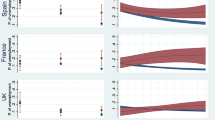Abstract
Unemployment rates increase with the level of education of the group surveyed in several developing countries. The goal of this paper is to provide a theoretical framework to study the determinants of this phenomenon. The model I present uses unemployment as a punishment device to force workers to perform well at work. The crucial assumption is that more educated workers can perform tasks that do not require much education and they chose to do so in the absence of unemployment insurance. This makes the threat of unemployment less harsh for educated workers and forces employers to decrease demand of educated employees in order to increase the punishment for them. I argue that this is a reasonable assumption to make in the case of two specific cases: Mexico and Egypt.
Similar content being viewed by others
References
Arabsheibani, G.: Supply and demand for graduates in Egypt. Higher Educ. Rev. 23(3), 55–60 (1991)
Assaad, R., El-Hamidi, F., Ahmed, A.: The determinant of employment status in Egypt. Discussion Paper, International Food Policy Research institute. Series number: 88 (2000)
Assad, R.: Unemployment and Youth Insertion in the Labor Market in Egypt. Working Paper, The Egyptian Center for Economic Studies (2007)
Bouillon, C., Legovini, A., Lustig, N.: Rising inequality in Mexico: household characteristics and regional effects. J. Dev. Stud. 39(4), 112–133 (2003)
Calvo, G.: On the inefficiency of unemployment. Q. J. Econ. 100(2), 373–387 (1985)
El-Hamidi, F.: General or vocational schooling? Evidence on school choice, return and ‘sheepskin effects’ from Egypt. J. Policy Reform 9(2), 157–176 (1998)
Fleck, S., Sorrentino, C.: Employment and unemployment in Mexico’s labor force. Mon. Labor Rev. 117(11), 3–31 (1994)
Frenk, J., Knaul, F., Vazquez, S.L., Nigenda, G.: Trends in medical employment: persistent imbalances in urban Mexico. Am. J. Public Health 89(7), 1054–1058 (1999)
Galal, A.: The Paradox of Education and Unemployment in Egypt. Working Paper, The Egyptian Center for Economic Studies (2002)
García-Díaza, C., Moreno-Monroy, A.I.: Social influence, agent heterogeneity and the emergence of the urban informal sector. Phys. A Stat. Mech. Appl. 391(4), 1563–1574 (2012)
Gong, X., van Soest A.: Wage differentials and mobility in the urban labour market: a panel data analysis for Mexico. IZA Discussion Paper 329 (2002)
Gong, X., van Soest, A., Villagomez, E.: Mobility in the Urban Labor Market: A Panel Data Analysis for Mexico. IZA Working Paper (2000)
Hassan, M., Sassanpour, C.: Labor market pressures in Egypt: why is the unemployment rate stubbornly high? J. Dev. Econ. Policies 10 (2008)
International Labor Organization, LABORSTA: Main statistics. Unemployment by level of education (in thousands) (2008)
Janvry, A., Sadoulet, E., Winters, P.: Family and community networks in Mexico-U.S. migration. J. Human Resour. 36(1), 159–184 (2001)
Levison, D., Moe, K., Knaul, F.: Youth education and work in Mexico. World Dev. 29(1), 167–188 (2001)
Lora, E., Marquez, G.: The employment problem in Latin America: perceptions and stylized facts. Inter-American Development Bank, Working Paper (1998)
Maloney, W.: Does informality imply segmentation of the labor markets? Evidence from sectoral transitions in Mexico. World Bank Econ. Rev. 13(2) (1999)
Marcouiller, D., Ruiz de Castilla, V., Woodruff, C.: Formal measures of the informal sector wage gap in Mexico. El Salvador and Peru. Econ. Dev. Cult. Change 45, 367–392 (1997)
National Geography and Statistics Institute (INEGI): Statistics. Consulta Interactiva de datos, Desempleo por nivel educativo (en miles) (2012)
Quinn, M., Rubb, S.: Mexico’s labor market: the importance of education-occupation matching on wages and productivity. Econ. Educ. Rev. 25(2), 147–156 (2006)
Ros, J.: Employment, structural adjustment and sustainable growth in Mexico. J. Dev. Stud. 36(4), 100–119 (2000)
Salop, S.: A model of the natural rate of unemployment. Am. Econ. Rev. 69(1), 117–125 (1979)
Shapiro, C., Stiglitz, J.: Equilibrium unemployment as a worker discipline device. Am. Econ. Rev. 74(3), 433–444 (1983)
Taylor, E., Yunez-Naude, A.: The determinants of nonfarm activities and incomes of rural households in mexico with emphasis on education. World Dev. 29(3), 561–572 (2001)
Author information
Authors and Affiliations
Corresponding author
Rights and permissions
About this article
Cite this article
Flores Vazquez, I.M. Equilibrium unemployment in the presence of different skill levels in two different regions: Mexico versus Egypt. Lett Spat Resour Sci 7, 121–131 (2014). https://doi.org/10.1007/s12076-013-0105-8
Received:
Accepted:
Published:
Issue Date:
DOI: https://doi.org/10.1007/s12076-013-0105-8




